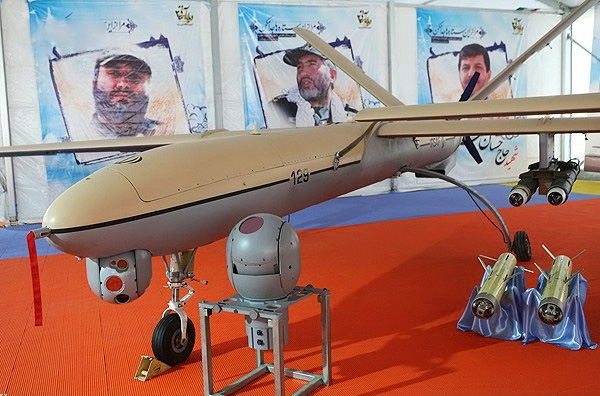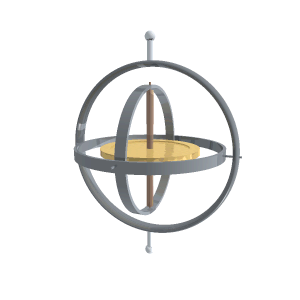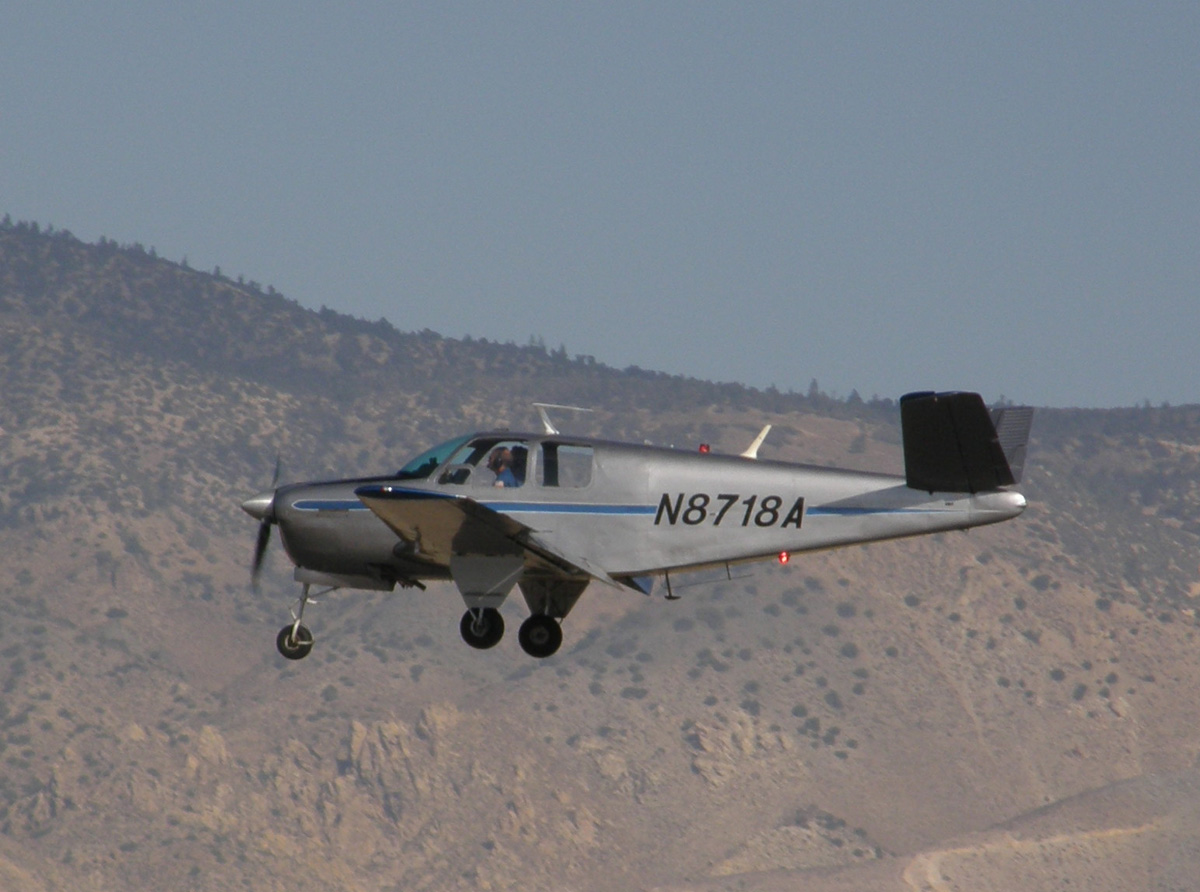|
Shaheed 129 (UCAV)
The Shahed 129 ( fa, شاهد ۱۲۹, English: "witness"; sometimes S129) is an Iranian single-engine medium-altitude long-endurance unmanned combat aerial vehicle (UCAV) designed by Shahed Aviation Industries for the Islamic Revolutionary Guard Corps (IRGC). The Shahed 129 is capable of combat and reconnaissance missions and has an endurance of 24 hours; it is similar in size, shape and role to the American MQ-1 Predator and is widely considered as one of the most capable drones in Iranian service. The UAV has been used for airstrikes in the Syrian Civil War and for border patrol on Iran's eastern border. As of 2017 the Shahed 129 and Saegheh are expected to form the backbone of Iran's high-end UAV fleet for at least the next decade. Development Development began in 2005 when Iran Aircraft Manufacturing Industrial Company (HESA) began design work on the HESA-100 UAV. This was essentially the same design as the Shahed 129 but was shorter and with a squarish fuselage ... [...More Info...] [...Related Items...] OR: [Wikipedia] [Google] [Baidu] |
Iran
Iran, officially the Islamic Republic of Iran, and also called Persia, is a country located in Western Asia. It is bordered by Iraq and Turkey to the west, by Azerbaijan and Armenia to the northwest, by the Caspian Sea and Turkmenistan to the north, by Afghanistan and Pakistan to the east, and by the Gulf of Oman and the Persian Gulf to the south. It covers an area of , making it the 17th-largest country. Iran has a population of 86 million, making it the 17th-most populous country in the world, and the second-largest in the Middle East. Its largest cities, in descending order, are the capital Tehran, Mashhad, Isfahan, Karaj, Shiraz, and Tabriz. The country is home to one of the world's oldest civilizations, beginning with the formation of the Elamite kingdoms in the fourth millennium BC. It was first unified by the Medes, an ancient Iranian people, in the seventh century BC, and reached its territorial height in the sixth century BC, when Cyrus the Great fo ... [...More Info...] [...Related Items...] OR: [Wikipedia] [Google] [Baidu] |
Drone Strike
Drone warfare is a form of aerial warfare using unmanned combat aerial vehicles (UCAV) or weaponized commercial unmanned aerial vehicles (UAV). The United States, United Kingdom, Israel, China, South Korea, Iran, Italy, France, India, Pakistan, Russia, Turkey, and Poland are known to have manufactured operational UCAVs as of 2019. As of 2022, the Ukrainian enterprise Ukroboronprom and NGO group Aerorozvidka have built strike-capable drones and used them in combat. Drone attacks can be conducted by commercial UCAVs dropping bombs, firing a missile, or crashing into a target. Since the turn of the century, most drone strikes have been carried out by the US military in such countries as Afghanistan, Pakistan, Syria, Iraq, Somalia and Yemen using air-to-surface missiles, but drone warfare has increasingly been deployed by Russia, Ukraine, Turkey, Azerbaijan and by militant groups such as the Houthis. Drones strikes are used for targeted killings by several countries. In 2020 a ... [...More Info...] [...Related Items...] OR: [Wikipedia] [Google] [Baidu] |
Spike-ER
Spike (Modern Hebrew, Hebrew: ספייק) is an Israeli fire-and-forget anti-tank guided missile and Anti-personnel weapon, anti-personnel missile with a tandem-charge high-explosive anti-tank (HEAT) warhead. , it is in its fourth generation. It was developed and designed by the Israeli company Rafael Advanced Defense Systems. It is available in man-portable, vehicle-launched, and helicopter-launched variants. The missile can engage and destroy targets within the line-of-sight of the launcher ("fire-and-forget"), and some variants can make a top attack through a "fire, observe and update" method (essentially lock-on after launch); the operator tracking the target, or switching to another target, optically through the trailing Optical fiber, fiber-optic wire (or RF link in the case of the vehicle-mounted, long-range NLOS variant) while the missile is climbing to altitude after launch. This is similar to the Projectile motion#Lofted trajectory, lofted trajectory flight profile of t ... [...More Info...] [...Related Items...] OR: [Wikipedia] [Google] [Baidu] |
Toophan
The Toophan ( fa, طوفان "typhoon", rarely Toofan) is an Iranian SACLOS anti-tank guided missile reverse-engineered from the American BGM-71 TOW missile. The Toophan 1, an unlicensed copy of the BGM-71A TOW missile, began mass production in 1988 and the Toophan 2, a BGM-71C ITOW variant, was publicly shown in 2000. The Toophan comes in at least 11 variants, many of which are poorly documented, including variants with laser guidance, thermobaric warheads, and tandem-warheads with increased penetration. The Toophan is manufactured jointly by the Aerospace Industries Organization of Iran and Iran Electronics Industries. It's normally deployed from ground-based tripods, and can also be mounted on fighting vehicles and helicopters. Like the BGM-71 TOW missile, the Toophan is a large, rugged, powerful, and reliable anti-tank guided missile deployed by small teams against tanks, armored vehicles, buildings, and other targets. The Toophan forms the backbone of the Iranian Armed Forc ... [...More Info...] [...Related Items...] OR: [Wikipedia] [Google] [Baidu] |
Television Guidance
Television guidance (TGM) is a type of missile guidance system using a television camera in the missile or glide bomb that sends its signal back to the launch platform. There, a weapons officer or bomb aimer watches the image on a television screen and sends corrections to the missile, typically over a radio control link. Television guidance is not a ''seeker'' because it is not automated, although semi-automated systems with autopilots to smooth out the motion are known. They should not be confused with contrast seekers, which also use a television camera but are true automated seeker systems. The concept was first explored by the Germans during World War II as an anti-shipping weapon that would keep the launch aircraft safely out of range of the target's anti-aircraft guns. The best-developed example was the Henschel Hs 293, but the TV guided versions did not see operational use. The US also experimented with similar weapons during the war, notably the GB-4 and Interstate TDR. Only ... [...More Info...] [...Related Items...] OR: [Wikipedia] [Google] [Baidu] |
Anti-tank Guided Missile
An anti-tank guided missile (ATGM), anti-tank missile, anti-tank guided weapon (ATGW) or anti-armor guided weapon is a guided missile primarily designed to hit and destroy heavily armored military vehicles. ATGMs range in size from shoulder-launched weapons, which can be transported by a single soldier, to larger tripod-mounted weapons, which require a squad or team to transport and fire, to vehicle and aircraft mounted missile systems. Earlier man-portable anti-tank weapons like anti-tank rifles and magnetic anti-tank mines, generally had very short range, sometimes on the order of metres or tens of metres. Rocket-propelled high-explosive anti-tank (HEAT) systems appeared in World War II and extended range to the order of hundreds of metres, but accuracy was low and hitting targets at these ranges was largely a matter of luck. It was the combination of rocket propulsion and remote wire guidance that made the ATGM much more effective than these earlier weapons, and gave lig ... [...More Info...] [...Related Items...] OR: [Wikipedia] [Google] [Baidu] |
Sadid-1
The Sadid-1 (also known as the Sadid-361, the Fat'h 362, and the Sadid-342) is an Iranian TV-guided anti-tank missile derived from Iran's Toophan missiles. It is described by multiple sources as similar in design to the Israeli Spike-ER missile, and was intended as the armament for Iran's Shahed 129 UAV. Specifications A mockup of the Sadid-1 was first seen at Iran's 2010 Kish Air Show. As of 2016, the Sadid-1's guidance system, laser/TV seeker and propulsion unit were still under development. Detailed information about the Sadid-1 has not been disclosed; however, it is believed to be about 140 cm long, to have a range of 4000 meters, and to have a maximum flight time of about thirty seconds. Operational history The Sadid-1 was a proposed armament for the Shahed 216, an exceptionally obscure attack helicopter proposal from HESA/Shahed Aviation around 2015. The Sadid-1 was not operationally deployed on the Shahed 129; one source says this was due to problems with the laun ... [...More Info...] [...Related Items...] OR: [Wikipedia] [Google] [Baidu] |
Shahed 129
The Shahed 129 ( fa, شاهد ۱۲۹, English: "witness"; sometimes S129) is an Iranian single-engine medium-altitude long-endurance unmanned combat aerial vehicle (UCAV) designed by Shahed Aviation Industries for the Islamic Revolutionary Guard Corps (IRGC). The Shahed 129 is capable of combat and reconnaissance missions and has an endurance of 24 hours; it is similar in size, shape and role to the American MQ-1 Predator and is widely considered as one of the most capable drones in Iranian service. The UAV has been used for airstrikes in the Syrian Civil War and for border patrol on Iran's eastern border. As of 2017 the Shahed 129 and Saegheh are expected to form the backbone of Iran's high-end UAV fleet for at least the next decade. Development Development began in 2005 when Iran Aircraft Manufacturing Industrial Company (HESA) began design work on the HESA-100 UAV. This was essentially the same design as the Shahed 129 but was shorter and with a squarish fuselage. Design ... [...More Info...] [...Related Items...] OR: [Wikipedia] [Google] [Baidu] |
Rotax 914
The Rotax 914 is a turbo-charged, four-stroke, four-cylinder, horizontally opposed aircraft engine with air-cooled cylinders and water-cooled cylinder heads. It is designed and built by the Austrian company BRP-Powertrain, owned by Bombardier Recreational Products (BRP), as part of its Rotax brand.Bayerl, Robby; Martin Berkemeier; et al: ''World Directory of Leisure Aviation 2011-12'', pages 242-243. WDLA UK, Lancaster UK, 2011. Tacke, Willi; Marino Boric; et al: ''World Directory of Light Aviation 2015-16'', pages 260-261. Flying Pages Europe SARL, 2015. The engine commonly powers certified light aircraft, homebuilt aircraft, autogyros and military UAVs such as the MQ-1 Predator. Design and development Introduced in 1996, the Rotax 914 is a turbocharged development of the Rotax 912. The Rotax 914 has a turbocharger with an automatic wastegate controller and dual carburettors. It features dual capacitor discharge ignition, liquid-cooled cylinder heads and air-cooled cylinde ... [...More Info...] [...Related Items...] OR: [Wikipedia] [Google] [Baidu] |
Gimbal
A gimbal is a pivoted support that permits rotation of an object about an axis. A set of three gimbals, one mounted on the other with orthogonal pivot axes, may be used to allow an object mounted on the innermost gimbal to remain independent of the rotation of its support (e.g. vertical in the first animation). For example, on a ship, the gyroscopes, shipboard compasses, stoves, and even drink holders typically use gimbals to keep them upright with respect to the horizon despite the ship's pitching and rolling. The gimbal suspension used for mounting compasses and the like is sometimes called a Cardan suspension after Italian mathematician and physicist Gerolamo Cardano (1501–1576) who described it in detail. However, Cardano did not invent the gimbal, nor did he claim to. The device has been known since antiquity, first described in the 3rd c. BC by Philo of Byzantium, although some modern authors support the view that it may not have a single identifiable inventor. Histo ... [...More Info...] [...Related Items...] OR: [Wikipedia] [Google] [Baidu] |
Pusher Configuration
In an aircraft with a pusher configuration (as opposed to a tractor configuration), the propeller(s) are mounted behind their respective engine(s). Since a pusher propeller is mounted behind the engine, the drive shaft is in compression in normal operation. Pusher configuration describes this specific (propeller or ducted fan) thrust device attached to a craft, either aerostat (airship) or aerodyne (aircraft, WIG, paramotor, rotorcraft) or others types such as hovercraft, airboat and propeller-driven snowmobiles. "Pusher configuration" also describes the layout of a fixed-wing aircraft in which the thrust device has a pusher configuration. This kind of aircraft is commonly called a pusher. Pushers have been designed and built in many different layouts, some of them quite radical. History The rubber-powered "Planophore", designed by Alphonse Pénaud in 1871, was an early successful model aircraft with a pusher propeller. Many early aircraft (especially biplanes) were ... [...More Info...] [...Related Items...] OR: [Wikipedia] [Google] [Baidu] |
V-tail
The V-tail or ''Vee-tail'' (sometimes called a butterfly tail or Rudlicki's V-tailGudmundsson S. (2013). "General Aviation Aircraft Design: Applied Methods and Procedures" (Reprint). Butterworth-Heinemann. p. 489. , 9780123973290) of an aircraft is an unconventional arrangement of the tail control surfaces that replaces the traditional fin and horizontal surfaces with two surfaces set in a V-shaped configuration. It is not widely used in aircraft design. The aft edge of each twin surface is a hinged control surface called a ruddervator, which combines the functions of both a rudder and elevator. The V-tail was invented in 1930 by Polish engineer Jerzy Rudlicki and was tested for the first time on the Hanriot H-28 trainer aircraft, modified by a Polish aerospace manufacturer Plage and Laśkiewicz in the summer of 1931. Variants The X-shaped tail surfaces of the experimental Lockheed XFV were essentially a V tail that extended both above and below the fuselage. Conventional ... [...More Info...] [...Related Items...] OR: [Wikipedia] [Google] [Baidu] |








